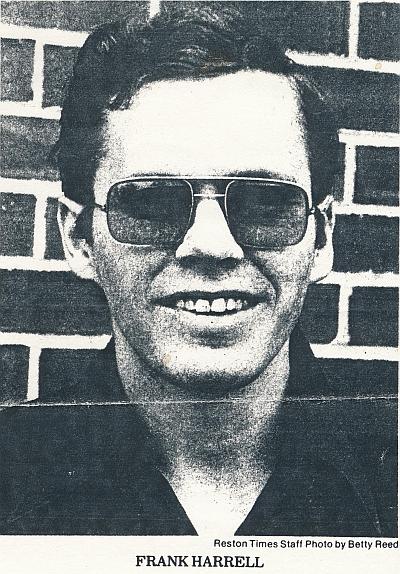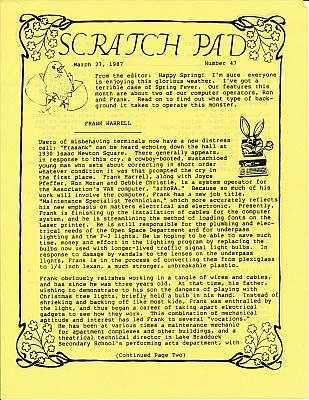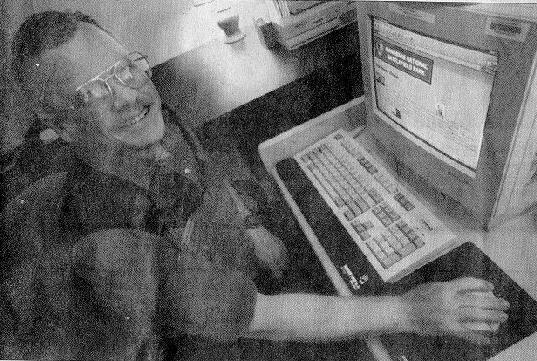The Reston Times was a small newspaper started in the late 1960's for the new town of Reston Virginia. Over the years it changed hands numorous times, eventually being absorbed by other regional publishing companies who in turn were absorbed by others. Its name has now been lost in history. This first article was written about 7 years before I aquired the nickname Cowboy Frank
I was the first resident technical director for the Reston Community Center (paid minimum wage for 20 hours a week, while putting in between 50 to 60 hours). I stayed there for a bit over a year before having a falling out with my supervisor and quit. She wanted me to design a lighting plan for her show, but refused to give me any ideas on how she wanted to stage the production. I was frustrated with the lack of information she would give me, a reoccurring theme that still causes me grief when I encounter that attitude within a group or company I am trying to help.
Reston, Va., Thursday, April 10, 1980
By BETTY REED
Reston Times Staff Writer
By his own admission, Frank Harrell doesn't smile very much. Never-the-less, he says he is a happy man.

He describes himself as shy and retiring. Yet ask him about the 480 square foot space that is his domain at the Reston Community Center and he will talk for hours.
He claims to be afraid of fire, but he says when he is serving as a volunteer fireman, and the alarm sounds, his adrenalin races.
Frank Harrell is a paradox.
From dawn to dusk (and sometimes to dawn again) Harrell is the Resident Technical Director at the Reston Community Center Theatre. His realm is the part of the house patrons rarely notice. During performances, Harrell sits in his aerie at the rear of the theater. There he twirls knobs and pushes switches, making the sound and light systems do their magic.
"I guess you could say I'm, a perfectionist. If you do a job perfectly," Harrell Says, "no one will notice .. But if you goof up one spot, everyone will see it."
Members of the audience have rarely had an opportunity to note a mistake in the handling of the more than 120 lights which make up the stage system, according to Helena de Crespo, artistic director of the center's theater.
Whenever Harrell's name comes up in a conversation, de Crespo murmurs with awe, "Frank is a genius. Frank can fix anything." There appears to be no sound or lighting task too big or too small for Harrell to attack. Much of the equipment in use at the theater is his own. He installed it himself, he says. He is sensitive to the needs of the various groups that use the stage for productions. If the system can't handle the demands, Harrell will devise a solution, he says.
Lighting the stage is not Harrell's only lighting concern. Recently, he says, he was worried about the quality of the aisle lights (those tiny beams that light the way when the houselights are out).
He thought the light was not diffused wcll enough, he says. Several weeks of experimentation led him to the solution for which he was looking. All 40 units had to be taken apart and a small piece of gell (a substance used on theater lights) was glued to the casing.
Now the lights cast a soft glow into a large portion of the aisle without being glaringly apparent.
"Nobody will ever know it was done, but I think little things like that are important," Harrell says.
The perfectionist says he is satisfied with the results.
Harrell became interested in theater during his high school days in West Springfield, but his interest in anything with wires started at a much earlier date.
As a 6-year-old he had an old crystal microphone.
"There wasn't a darn thing I could do with it," he says, but it was a fascinating toy.
Then, he bought a tape recorder from a friend.
"Actually I sto!e it for $3," Harrell says.
That event began his love affair with sound.
Harrell's father, a professional photographer and movie-maker with the Smithsonian Institution, encouraged his son to use his personal equipment. That whetted his appetite, he says, and by the time he got to high school he was ready for more of a challenge.
One day, he says, he worked up his nerve to ask the school librarian how to use the 16mm projector.
"The next day I was in charge of the audio-visual department," he says.
Then a guidance counselor advised Harrell to join the audio-visual club at the school.
"And that's how I got to be the sound engineer for 'Oliver'," he says.
From that moment on, Harrell says, he knew what he wanted. A brief career on stage reinforced his desire to work behind the scenes.
Of his portrayal of a character in the melodrama "Deadwood Dick" Harrell says, "I had only two lines and I blew one of them."
Upon graduation there was a short stint with the phone company, then Harrell found the theatre at Lake Braddock Secondary School.
"I fell in love with the control room and never wanted to leave," he says.
After serving as a volunteer, Harrell was hired by the county as the resident technical director. Unfortunately there was no job description nor were there any funds for such a position, Harrell says.
As far as the county was concerned, Harrell was a part-time clerical typist - the only job with funding available.
When school was out for the summer Harrell filled his time preparing for the International Children's Festival at Wolf Trap Farm Park. For two seasons he acted as technical director for the event. [2013 note: this was the 2nd and 3rd years of the International Children's Festivle at Wolf Trap]
The festival is the biggest single production at the Filene Center. There are seven stages in use all day long for three days. A total of 60 companies perform. Out of all those performances Harrell can say, with just pride, that only two small mistakes were made by any technical crew member.
When the county ran out of funds, Harrell continued at Lake Braddock under contract with the school. Eventually, that arrangement was no longer financially feasible. At about that time, Harrell says he heard that the Reston Community Center was due to open.
Harrell says he hated to leave Braddock's $20,000 technical console, much of which he had put together himself, but the promise of a new horizon was too much to ignore.
On the few nights when he is not needed at the center, Harrell says he beds down at the Company #1 fire station in McLean. The excitement of a fire is secondary to the enjoyment of being able to help people and save lives, he says.
"I'm crazy about anything with flashing lights ... and of course you get to play with a lot of water. I'm basically just a little kid," he says with that seldom seen smile.
Harrell also puts in a few hours a week behind the counter at a drug store. He claims that job enables him to support his "bad habit" of eating.
"I don't tend to look at the future. I just let my lifestyle flow as it comes. I'm of the opinion that if I try to concern myself with what I should do in the future, it tends to break down the way I operate now."
Visit the Reston Community Center's Website
The Scratch Pad was a small internal orginizational newsletter published by the Reston Association (RA, previously called The Reston Homeowners Association). I had been hired to work with the wiring of their Digital Equipment Corportation (DEC) VAX 11/750 mini computer. W It had 2 hard drives, a 10 meg and a 90 meg, each took up a box 18 inches wide, 36 inches deep and about 48 inches high. They had obtained the computer used. It was several years later that the 11/750 was retired and replaced with PCs and a network server.

March 27, 1987. Number 47
Users of misbehaving terminals now have a new distress call: "Fraaank" can be heard echoing down the hall at 1930 Isaac Newton Square. There generally appears, in response to this cry, a cowboy-booted, mustachioed young man who sets about correcting in short order whatever condition it was that prompted the cry in the first place. Frank Harrell, along with Joyce Pfeffer, Ron Moran and Debbie Christie, is a system operator for the Association's VAX computer, "arhoRA." Because so much of his work will involve the computer, Frank has a new job title, "Maintenance Specialist Technician," which more accurately reflects his new emphasis on matters electrical and electronic. Presently, Frank is finishing up the installation of cables for the computer system, and he is streamlining the method of loading fonts on the Laser printer. He is still responsible for the plumbing and electrical needs of the Open Space Department and for underpass lighting and the F-2 lights. He is hoping to be able to save much time, money and effort in the lighting program by replacing the bulbs now used with longer-lived traffic signal light bulbs. In response to damage by vandals to the lenses on the underpass lights, Frank is in the process of converting them from plexiglass to 1/4 inch lexan, a much stronger, unbreakable plastic.
Frank obviously relishes working in a tangle of wires and cables, and has since he was three years old. At that time, his father, wishing to demonstrate to his son the dangers of playing with Christmas tree lights, briefly held a bulb in his hand. Instead of shrieking and backing off like most kids, Frank was enthralled by the light, and thus began a career of taking apart electrical gadgets to see how they work. This combination of mechanical aptitude and interest has led Frank to several "vocations." He has been at various times a maintenance mechanic for apartment complexes and other buildings, and a theatrical technical director in Lake Braddock Secondary School's performing arts department, with Wolf Trap's International Children's Festival, and at the Reston Community Center. Immediately before he carne to Reston Association, Frank worked for Warner Cable.
To the benefit of the Association, Frank enjoys solving problems. He has begun installing telephone-style jacks to make terminals more mobile. He is rewiring the computer system using less cable, a process he compares to "rerouting Shirley Highway without interfering with traffic."
Frank was born in Rocky Mount, North Carolina, but he moved to the Washington area when he was ten years old. His father, a photographer for the Smithsonian, taught Frank how to make amateur movies. Making quality videos is still a prime interest of Frank's. He loves riding motor cycles, hiking, and listening to classical music (those of us who work at Isaac Newton get treated to the strains of Bach, Beethovan and Handel when we refill our coffee cups).
Frank doesn't leave his penchant for technical innovation at the office. His house is a "gadgeteer's dream." Tied into his home computer are three thermostats, the coffee pot and the bathroom heater. Besides computer-regulating these creature comforts, Frank has done a lot of creative lighting throughout his place on Chimney House Road.
Those of us who have come to rely on the efficiencies of computer technology are grateful to Frank's dad for introducing him to the wonders of the light bulb. Otherwise, the Association might not be lucky enough to have Frank, the Trouble Shooting Technician, on staff.
See the entire newsletter in PDF form, (2.4 megs)
Visit the Reston Association's current website
The Diference is Reston You Tube videeo of a slide show I helped develope describing what Reston was all about. Originally produced in 1987, there is mention in the full newsletter about updating the orginization name in the slide show.The Potomac News, was a local Northern Virginia newspaper, which was being published while I was volunteering at Manassas Battlefield. I had been working on the Park's web page for about 3 months when this article appeared in the paper. The Potomac News has changed hands several times and is no longer in production as an independent. W
June 30, 1996
 By Mike Fuchs,
By Mike Fuchs,Frank Harrell clicks his mouse, revealing a colored map of Manassas National Battlefield Park.
A few more clicks reveal computer scanned photos of President Lincoln, Civil War generals and local landmarks.
Harrell, 45, is reviewing his latest work - the recently completed home page for Manassas National Battlefield Park on the World Wide Web.
Putting the park on the Internet was easy for Harrell, a self-proclaimed "computer nut who has volunteered more than 3,000 hours at the park during the past three years.
"It's a lot of fun," he said during a recent interview at his park office near U.S. 29 and Pageland Lane.
"The goal is to have general information about the park." he said.
Park superintendent Robert Sutton considers Harrell's computer work critical. Harrell installed the park's computers. He also installed the wiring at the recently relocated park headquarters.
It's also saving taxpayers more than a $100,000 in tight budget times, said Sutton, referring to the cost of hiring a computer expert.
"If he ever left I would have a major rebellion." Sutton said. "He is very highly thought of by everybody in the park."
Indeed, Harrell even has his own parking space. Not even Sutton has that.
The park home page, meanwhile, offers the public a chance to comment on the 5,100 acre park, which features 30 miles of hiking trials, guided tours, a visitors center and historic landmarks.
More than 800,000 people visit the park annually.
Residents, for example, can e-mail the park about proposed changes to the 1983 general management plan, which is expected to be revised in August 1998.
The plan can also be reviewed on the park home page. The e-mail address is (no longer the same).
Harrell can afford to volunteer full time at the park. A few wise land investments and an inheritance enabled him to quit his last job. He worked as a computer assistant at the Reston Homeowners Association in the late 1980s.
He was the Reston Community Center's technical director in the early 1980s, and served as a service technician for Warner Cable in Reston for five years.
"It gives me a lot of enjoyment to be able to help." he said. I really love the parks. It's a good place to volunteer."
Park enthusiasts can access the home page by typing www.nps.gov/mana.
The work I did for the National Park website back in the 1990s is no longer there, but you can still see most of my original park website work on my history site.